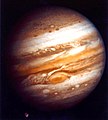Fexeiro:Jupiter gany.jpg

Tamanho desta antebison: 538 × 600 píxeles. Outras resoluçones: 215 × 240 píxeles | 431 × 480 píxeles | 673 × 750 píxeles.
Fexeiro oureginal (673 × 750 píxeles, tamanho: 114 KB, tipo MIME: image/jpeg)
Stórico de l fexeiro
Clique an ua data/hora para ber l fexeiro tal cumo el staba naquel sfergante.
| Data i hora | Amostra | Tamanho | Outelizador | Comentairo | |
|---|---|---|---|---|---|
| atual | 10h17min de 15 de outubre de 2023 |  | 673 × 750 (114 KB) | 0x0a | offcial JPG, more details |
| 08h19min de 16 de febreiro de 2016 |  | 970 × 1 081 (281 KB) | PlanetUser | black bg | |
| 04h20min de 15 de márcio de 2015 |  | 970 × 1 081 (72 KB) | Jcpag2012 | larger (with auto correction) from TIFF file | |
| 05h24min de 22 de febreiro de 2015 |  | 758 × 858 (238 KB) | Jcpag2012 | processing | |
| 04h14min de 9 de nobembre de 2004 |  | 758 × 858 (58 KB) | Gentgeen | {{PD-USGov-NASA}} |
Lhigaçones de l fexeiro
Esta páigina lhiga este fexeiro:
Outelizaçon global dun fexeiro
Las seguintes wikis outelizan este fexeiro:
- Outelizaçon na af.wikipedia.org
- Outelizaçon na ar.wikipedia.org
- Outelizaçon na be.wikipedia.org
- Outelizaçon na bg.wikipedia.org
- Outelizaçon na cs.wikipedia.org
- Outelizaçon na en.wikipedia.org
- Outelizaçon na en.wiktionary.org
- Outelizaçon na es.wikipedia.org
- Outelizaçon na et.wikipedia.org
- Outelizaçon na eu.wikipedia.org
- Outelizaçon na fr.wikipedia.org
- Outelizaçon na gu.wikipedia.org
- Outelizaçon na he.wikipedia.org
- Outelizaçon na hi.wikipedia.org
- Outelizaçon na hr.wikipedia.org
- Outelizaçon na hr.wiktionary.org
- Outelizaçon na hy.wikipedia.org
- Outelizaçon na id.wikipedia.org
- Outelizaçon na it.wikipedia.org
- Outelizaçon na it.wiktionary.org
- Outelizaçon na ja.wikipedia.org
- Outelizaçon na ja.wiktionary.org
- Outelizaçon na kbp.wikipedia.org
- Outelizaçon na la.wikipedia.org
- Outelizaçon na mdf.wikipedia.org
- Outelizaçon na mk.wikipedia.org
- Outelizaçon na ml.wikipedia.org
- Outelizaçon na mr.wikipedia.org
- Outelizaçon na nl.wikipedia.org
- Outelizaçon na no.wikipedia.org
- Outelizaçon na pl.wikiquote.org
- Outelizaçon na ps.wikipedia.org
- Outelizaçon na pt.wikipedia.org
Ber la outelizaçon global deste fexeiro.


